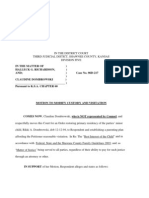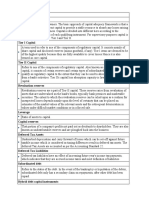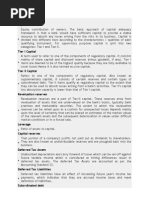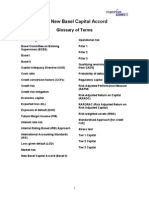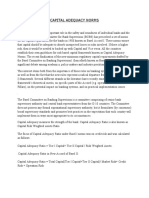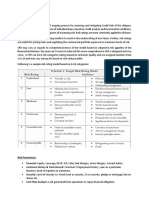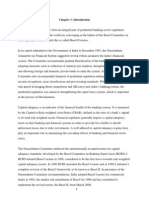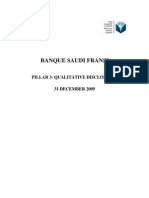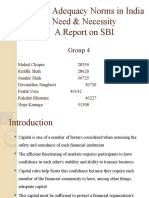Economics Glossary PDF
Economics Glossary PDF
Uploaded by
SK PCopyright:
Available Formats
Economics Glossary PDF
Economics Glossary PDF
Uploaded by
SK POriginal Description:
Original Title
Copyright
Available Formats
Share this document
Did you find this document useful?
Is this content inappropriate?
Copyright:
Available Formats
Economics Glossary PDF
Economics Glossary PDF
Uploaded by
SK PCopyright:
Available Formats
7/11/13
Reserve Bank of India
SITEMA P FA Qs GLOSSA RY A BOUT US NOTIFICA TIONS PUBLICA TIONS DA TA BA SE SPEECHES PRESS RELEA SES TENDERS
A TS OTHER LINKS CONTA CT US EVENTS
DISCLA IMER
FORMS
A PPLICA TION TRA CKING SYSTEM
Capital Earnings Funds and Investment Asset Securitisation NDS-OM Web
Home - Glossary
Capital Capital Funds Equity contribution of owners. The basic approach of capital adequacy framework is that a bank should have sufficient capital to provide a stable resource to absorb any losses arising from the risks in its business. Capital is divided into different tiers according to the characteristics / qualities of each qualifying instrument. For supervisory purposes capital is split into two categories: Tier I and Tier II. Tier I Capital A term used to refer to one of the components of regulatory capital. It consists mainly of share capital and disclosed reserves (minus goodwill, if any). Tier I items are deemed to be of the highest quality because they are fully available to cover losses Hence it is also termed as core capital. Tier II Capital Refers to one of the components of regulatory capital. Also known as supplementary capital, it consists of certain reserves and certain types of subordinated debt. Tier II items qualify as regulatory capital to the extent that they can be used to absorb losses arising from a bank's activities. Tier II's capital loss absorption capacity is lower than that of Tier I capital. Revaluation reserves Revaluation reserves are a part of Tier-II capital. These reserves arise from revaluation of assets that are undervalued on the bank's books, typically bank premises and marketable securities. The extent to which the revaluation reserves can be relied upon as a cushion for unexpected losses depends mainly upon the level of certainty that can be placed on estimates of the market values of the relevant assets and the subsequent deterioration in values under difficult market conditions or in a forced sale. Leverage Ratio of assets to capital. Capital reserves That portion of a company's profits not paid out as dividends to shareholders. They are also known as undistributable reserves and are ploughed back into the business. Deferred Tax Assets Unabsorbed depreciation and carry forward of losses which can be set-off against future taxable income which is considered as timing differences result in deferred tax assets. The deferred Tax Assets are accounted as per the Accounting Standard 22. Deferred Tax Liabilities Deferred tax liabilities have an effect of increasing future year's income tax payments, which indicates that they are accrued income taxes and meet definition of liabilities. Subordinated debt Refers to the status of the debt. In the event of the bankruptcy or liquidation of the debtor, subordinated debt only has a secondary claim on repayments, after other debt has been repaid. Hybrid debt capital instruments In this category, fall a number of capital instruments, which combine certain characteristics of equity and certain characteristics of debt. Each has a particular feature, which can be considered to affect its quality as capital. Where these instruments have close similarities to equity, in particular when they are able to support losses on an ongoing basis without triggering liquidation, they may be included in Tier II capital. BASEL Committee on Banking Supervision
www.rbi.org.in/scripts/Glossary.aspx 1/9
7/11/13
BASEL Committee on Banking Supervision The BASEL Committee is a committee of bank supervisors consisting of members from each of the G10 countries. The Committee is a forum for discussion on the handling of specific supervisory problems. It coordinates the sharing of supervisory responsibilities among national authorities in respect of banks' foreign establishments with the aim of ensuring effective supervision of banks' activities worldwide. BASEL Capital accord The BASEL Capital Accord is an Agreement concluded among country representatives in 1988 to develop standardised risk-based capital requirements for banks across countries. The Accord was replaced with a new capital adequacy framework (BASEL II), published in June 2004. BASEL II is based on three mutually reinforcing pillars hat allow banks and supervisors to evaluate properly the various risks that banks face. These three pillars are: Minimum capital requirements, which seek to refine the present measurement framework supervisory review of an institution's capital adequacy and internal assessment process; market discipline through effective disclosure to encourage safe and sound banking practices Risk Weighted Asset The notional amount of the asset is multiplied by the risk weight assigned to the asset to arrive at the risk weighted asset number. Risk weight for different assets vary e.g. 0% on a Government Dated Security and 20% on a AAA rated foreign bank etc. CRAR(Capital to Risk Weighted Assets Ratio) Capital to risk weighted assets ratio is arrived at by dividing the capital of the bank with aggregated risk weighted assets for credit risk, market risk and operational risk. The higher the CRAR of a bank the better capitalized it is. Credit Risk The risk that a party to a contractual agreement or transaction will be unable to meet its obligations or will default on commitments. Credit risk can be associated with almost any financial transaction. BASEL-II provides two options for measurement of capital charge for credit risk 1.standardised approach (SA) - Under the SA, the banks use a risk-weighting schedule for measuring the credit risk of its assets by assigning risk weights based on the rating assigned by the external credit rating agencies. 2. Internal rating based approach (IRB) - The IRB approach, on the other hand, allows banks to use their own internal ratings of counterparties and exposures, which permit a finer differentiation of risk for various exposures and hence delivers capital requirements that are better aligned to the degree of risks. The IRB approaches are of two types: a) Foundation IRB (FIRB): The bank estimates the Probability of Default (PD) associated with each borrower, and the supervisor supplies other inputs such as Loss Given Default (LGD) and Exposure At Default (EAD). b) Advanced IRB (AIRB): In addition to Probability of Default (PD), the bank estimates other inputs such as EAD and LGD. The requirements for this approach are more exacting. The adoption of advanced approaches would require the banks to meet minimum requirements relating to internal ratings at the outset and on an ongoing basis such as those relating to the design of the rating system, operations, controls, corporate governance, and estimation and validation of credit risk components, viz., PD for both FIRB and AIRB and LGD and EAD for AIRB. The banks should have, at the minimum, PD data for five years and LGD and EAD data for seven years. In India, banks have been advised to compute capital requirements for credit risk adopting the SA. Market risk Market risk is defined as the risk of loss arising from movements in market prices or rates away from the rates or prices set out in a transaction or agreement. The capital charge for market risk was introduced by the BASEL Committee on Banking Supervision through the Market Risk Amendment of January 1996 to the capital accord of 1988 (BASEL I Framework). There are two methodologies available to estimate the capital requirement to cover market risks: 1) The Standardised Measurement Method: This method, currently implemented by the Reserve Bank, adopts a building block approach for interest-rate related and equity instruments which differentiate capital requirements for specific risk from those of general market risk. The specific risk charge is designed to protect against an adverse movement in the price of an individual security due to factors related to the individual issuer. The general market risk charge is designed to protect against the interest rate risk in the portfolio. 2) The Internal Models Approach (IMA): This method enables banks to use their proprietary inhouse method which must meet the qualitative and quantitative criteria set out by the BCBS and is subject to the explicit approval of the supervisory authority. Operational Risk The revised BASEL II framework offers the following three approaches for estimating capital charges for operational risk:
Reserve Bank of India
www.rbi.org.in/scripts/Glossary.aspx
2/9
7/11/13
charges for operational risk: 1) The Basic Indicator Approach (BIA): This approach sets a charge for operational risk as a fixed percentage ("alpha factor") of a single indicator, which serves as a proxy for the banks risk exposure. 2) The Standardised Approach (SA): This approach requires that the institution separate its operations into eight standard business lines, and the capital charge for each business line is calculated by multiplying gross income of that business line by a factor (denoted beta) assigned to that business line. 3) Advanced Measurement Approach (AMA): Under this approach, the regulatory capital requirement will equal the risk measure generated by the banks internal operational risk measurement system. In India, the banks have been advised to adopt the BIA to estimate the capital charge for operational risk and 15% of average gross income of last three years is taken for calculating capital charge for operational risk. Internal Capital Adequacy Assessment Process (ICAAP) In terms of the guidelines on BASEL II, the banks are required to have a board-approved policy on internal capital adequacy assessment process (ICAAP) to assess the capital requirement as per ICAAP at the solo as well as consolidated level. The ICAAP is required to form an integral part of the management and decision-making culture of a bank. ICAAP document is required to clearly demarcate the quantifiable and qualitatively assessed risks. The ICAAP is also required to include stress tests and scenario analyses, to be conducted periodically, particularly in respect of the banks material risk exposures, in order to evaluate the potential vulnerability of the bank to some unlikely but plausible events or movements in the market conditions that could have an adverse impact on the banks capital. Supervisory Review Process (SRP) Supervisory review process envisages the establishment of suitable risk management systems in banks and their review by the supervisory authority. The objective of the SRP is to ensure that the banks have adequate capital to support all the risks in their business as also to encourage them to develop and use better risk management techniques for monitoring and managing their risks. Market Discipline Market Discipline seeks to achieve increased transparency through expanded disclosure requirements for banks. Credit risk mitigation Techniques used to mitigate the credit risks through exposure being collateralised in whole or in part with cash or securities or guaranteed by a third party. Mortgage Back Security A bond-type security in which the collateral is provided by a pool of mortgages. Income from the underlying mortgages is used to meet interest and principal repayments. Derivative A derivative instrument derives its value from an underlying product. There are basically three derivatives a) Forward Contract- A forward contract is an agreement between two parties to buy or sell an agreed amount of a commodity or financial instrument at an agreed price, for delivery on an agreed future date. Future Contract- Is a standardized exchange tradable forward contract executed at an exchange. In contrast to a futures contract, a forward contract is not transferable or exchange tradable, its terms are not standardized and no margin is exchanged. The buyer of the forward contract is said to be long on the contract and the seller is said to be short on the contract. b) Options- An option is a contract which grants the buyer the right, but not the obligation, to buy (call option) or sell (put option) an asset, commodity, currency or financial instrument at an agreed rate (exercise price) on or before an agreed date (expiry or settlement date). The buyer pays the seller an amount called the premium in exchange for this right. This premium is the price of the option. c) Swaps- Is an agreement to exchange future cash flow at pre-specified Intervals. Typically one cash flow is based on a variable price and other on affixed one. Duration Duration (Macaulay duration) measures the price volatility of fixed income securities. It is often used in the comparison of interest rate risk between securities with different coupons and different maturities. It is defined as the weighted average time to cash flows of a bond where the weights are nothing but the present value of the cash flows themselves. It is expressed in years. The duration of a fixed income security is always shorter than its term to maturity, except in the case of zero coupon securities where they are the same. Modified Duration Modified Duration = Macaulay Duration/ (1+y/m), where y is the yield (%), m is the number of
Reserve Bank of India
www.rbi.org.in/scripts/Glossary.aspx
3/9
7/11/13
Modified Duration = Macaulay Duration/ (1+y/m), where y is the yield (%), m is the number of times compounding occurs in a year. For example if interest is paid twice a year m=2. Modified Duration is a measure of the percentage change in price of a bond for a 1% change in yield. Non Performing Assets (NPA) An asset, including a leased asset, becomes non performing when it ceases to generate income for the bank. Net NPA Gross NPA (Balance in Interest Suspense account + DICGC/ECGC claims received and held pending adjustment + Part payment received and kept in suspense account + Total provisions held). Coverage Ratio Equity minus net NPA divided by total assets minus intangible assets. Slippage Ratio (Fresh accretion of NPAs during the year/Total standard assets at the beginning of the year)*100 Restructuring A restructured account is one where the bank, grants to the borrower concessions that the bank would not otherwise consider. Restructuring would normally involve modification of terms of the advances/securities, which would generally include, among others, alteration of repayment period/ repayable amount/ the amount of installments and rate of interest. It is a mechanism to nurture an otherwise viable unit, which has been adversely impacted, back to health. Substandard Assets A substandard asset would be one, which has remained NPA for a period less than or equal to 12 months. Such an asset will have well defined credit weaknesses that jeopardize the liquidation of the debt and are characterised by the distinct possibility that the banks will sustain some loss, if deficiencies are not corrected. Doubtful Asset An asset would be classified as doubtful if it has remained in the substandard category for a period of 12 months. A loan classified as doubtful has all the weaknesses inherent in assets that were classified as substandard, with the added characteristic that the weaknesses make collection or liquidation in full, - on the basis of currently known facts, conditions and values highly questionable and improbable. Doubtful Asset An asset would be classified as doubtful if it has remained in the substandard category for a period of 12 months. A loan classified as doubtful has all the weaknesses inherent in assets that were classified as substandard, with the added characteristic that the weaknesses make collection or liquidation in full, - on the basis of currently known facts, conditions and values highly questionable and improbable. Loss Asset A loss asset is one where loss has been identified by the bank or internal or external auditors or the RBI inspection but the amount has not been written off wholly. In other words, such an asset is considered uncollectible and of such little value that its continuance as a bankable asset is not warranted although there may be some salvage or recovery value. Off Balance Sheet Exposure Off-Balance Sheet exposures refer to the business activities of a bank that generally do not involve booking assets (loans) and taking deposits. Off-balance sheet activities normally generate fees, but produce liabilities or assets that are deferred or contingent and thus, do not appear on the institution's balance sheet until and unless they become actual assets or liabilities. Current Exposure Method The credit equivalent amount of a market related off-balance sheet transaction is calculated using the current exposure method by adding the current credit exposure to the potential future credit exposure of these contracts. Current credit exposure is defined as the sum of the positive mark to market value of a contract. The Current Exposure Method requires periodical calculation of the current credit exposure by marking the contracts to market, thus capturing the current credit exposure. Potential future credit exposure is determined by multiplying the notional principal amount of each of these contracts irrespective of whether the contract has a zero, positive or negative mark-to-market value by the relevant add-on factor prescribed by RBI, according to the nature and residual maturity of the instrument.
Reserve Bank of India
www.rbi.org.in/scripts/Glossary.aspx
4/9
7/11/13
Reserve Bank of India
Earnings Total income Sum of interest/discount earned, commission, exchange, brokerage and other operating income. Total operating expenses Sum of interest expended, staff expenses and other overheads. Operating profit before provisions Net of total income and total operating expenses. Net operating profit Operating profit before provision minus provision for loan losses, depreciation in investments, write off and other provisions. Profit before tax (PBT) (Net operating profit +/- realized gains/losses on sale of assets) Profit after tax (PAT) Profit before tax provision for tax. Retained earnings Profit after tax dividend paid/proposed. Average Yield (Interest and discount earned/average interest earning assets)*100 Average cost (Interest expended on deposits and borrowings/Average interest bearing liabilities)*100 Return on Asset (ROA)- After Tax Return on Assets (ROA) is a profitability ratio which indicates the net profit (net income) generated on total assets. It is computed by dividing net income by average total assets. Formula- (Profit after tax/Av. Total assets)*100 Return on equity (ROE)- After Tax Return on Equity (ROE) is a ratio relating net profit (net income) to shareholders equity. Here the equity refers to share capital reserves and surplus of the bank. Formula- Profit after tax/(Total equity + Total equity at the end of previous year)/2}*100 Accretion to equity (Retained earnings/Total equity at the end of previous year)*100 Net Non-Interest Income The differential (surplus or deficit) between non-interest income and non-interest expenses as a percentage to average total assets. Net Interest Income ( NII) The NII is the difference between the interest income and the interest expenses. Net Interest Margin Net interest margin is the net interest income divided by average interest earning assets. Cost income ratio (Efficiency ratio) The cost income ratio reflects the extent to which non-interest expenses of a bank make a charge on the net total income (total income interest expense). The lower the ratio, the more efficient is the bank. Formula: Non interest expenditure / Net Total Income * 100.
Funds and Investment CASA Deposit Deposit in bank in current and Savings account. High Cost Deposit Deposits accepted above card rate (for the deposits) of the bank. Liquid Assets Liquid assets consists of: cash, balances with RBI, balances in current accounts with banks, money at call and short notice, inter-bank placements due within 30 days and securities under held for trading and available for sale categories excluding securities that do not have ready
www.rbi.org.in/scripts/Glossary.aspx 5/9
7/11/13
held for trading and available for sale categories excluding securities that do not have ready market. Funding Volatility Ratio Liquid assets [as above] to current and savings deposits - (Higher the ratio, the better) Market Liability Ratio Inter-bank and money market deposit liabilities to Average Total Assets ALM Asset Liability Management (ALM) is concerned with strategic balance sheet management involving all market risks. It also deals with liquidity management, funds management, trading and capital planning. ALCO Asset-Liability Management Committee (ALCO) is a strategic decision making body, formulating and overseeing the function of asset liability management (ALM) of a bank. Banking Book The banking book comprises assests and liabilities, which are contracted basically on account of relationship or for steady income and statutory obligations and are generally held till maturity. Venture Capital Fund A fund set up for the purpose of investing in startup businesses that is perceived to have excellent growth prospects but does not have access to capital markets. Held Till Maturity(HTM) The securities acquired by the banks with the intention to hold them up to maturity. Held for Trading(HFT) Securities where the intention is to trade by taking advantage of short-term price / interest rate movements. Available for Sale(AFS) The securities available for sale are those securities where the intention of the bank is neither to trade nor to hold till maturity. These securities are valued at the fair value which is determined by reference to the best available source of current market quotations or other data relative to current value. Yield to maturity (YTM) or Yield The Yield to maturity (YTM) is the yield promised to the bondholder on the assumption that the bond will be held to maturity and coupon payments will be reinvested at the YTM. It is a measure of the return of the bond. Convexity This represents the rate of change of duration. It is the difference between actual price of a bond and the price estimated by modified duration. Foreign Currency Convertible Bond A bond issued in foreign currency abroad giving the investor the option to convert the bond into equity at a fixed conversion price or as per a pre-determined pricing formula. Trading Book Investments in trading book are held for generating profits on the short term differences in prices/yields. Held for trading (HFT) and Available for sale (AFS) category constitute trading book. CRR Cash reserve ratio is the cash parked by the banks in their specified current account maintained with RBI. SLR Statutory liquidity ratio is in the form of cash (book value), gold (current market value) and balances in unencumbered approved securities. Stress testing Stress testing is used to evaluate a banks potential vulnerability to certain unlikely but plausible events or movements in financial variables. The vulnerability is usually measured with reference to the banks profitability and /or capital adequacy. Scenario Analysis A method in which the earnings or value impact is computed for different interest rate scenario.
Reserve Bank of India
www.rbi.org.in/scripts/Glossary.aspx
6/9
7/11/13
Reserve Bank of India
LIBOR London Inter Bank Offered Rate. The interest rate at which banks offer to lend funds in the interbank market. Basis Point Is one hundredth of one percent. 1 basis point means 0.01%. Used for measuring change in interest rate/yield. Fraud Frauds have been classified as under, based mainly on the provisions of the Indian Penal Code (a) Misappropriation and criminal breach of trust. (b) Fraudulent encashment through forged instruments, manipulation of books of account or through fictitious accounts and conversion of property. (c) Unauthorised credit facilities extended for reward or for illegal gratification. (d) Negligence and cash shortages. (e) Cheating and forgery. (f) Irregularities in foreign exchange transactions. (g) Any other type of fraud not coming under the specific heads as above.
Asset Securitisation Securitization A process by which a single asset or a pool of assets are transferred from the balance sheet of the originator (bank) to a bankruptcy remote SPV (trust) in return for an immediate cash payment. Special Purpose Vehicle (SPV) An entity which may be a trust, company or other entity constituted or established by a Deed or Agreement for a specific purpose. Bankruptcy remote The legal position with reference to the creation of the SPV should be such that the SPV and its assets would not be touched in case the originator of the securitization goes bankrupt and its assets are liquidated. Credit enhancement These are the facilities offered to an SPV to cover the probable losses from the pool of securitized assets. It is a credit risk cover given by the originator or a third party and meant for the investors in any securitization process. Custodian An entity, usually a bank that actually holds the receivables as agent and bailee of the trustee. First loss facility First level of credit enhancement offered to an SPV as part of the process in bringing the securities issued by SPV to investment grade. Second loss facility Credit enhancement providing the second or subsequent tier of protection to an SPV against potential losses. Value at Risk (VAR) VAR is a single number (currency amount) which estimates the maximum expected loss of a portfolio over a given time horizon (the holding period) and at a given confidence level. VaR is defined as an estimate of potential loss in a position or asset/liability or portfolio of assets/liabilities over a given holding period at a given level of certainty. The following are the three main methodologies used to calculate VaR: Parametric Estimates Estimates VaR using parameters such as volatility and correlation. Accurate for traditional assets and linear derivatives, but less accurate for non linear derivatives. Monte Carlo simulation- Estimates VaR by simulating random scenarios and revaluing positions in the portfolio. Appropriate for all types of instruments, linear and nonlinear. Historical simulation- Estimates VaR by reliving history; takes actual historical rates and revalues positions for each change in the market Commercial real estate commercial real estate is defined as fund based and non-fund based exposures secured by mortgages on commercial real estates (office buildings, retail space, multi-purpose commercial premises, multi-family residential buildings, multi-tenanted commercial premises, industrial or warehouse space, hotels, land acquisition, development and construction etc.)
www.rbi.org.in/scripts/Glossary.aspx 7/9
7/11/13
Reserve Bank of India
NDS-OM Web Primary Member (PM) A member of NDS-OM (having Constituent Subsidiary General Ledger (CSGL) and current account with RBI) who authorizes their Gilt Account Holders to have direct access to the web enabled NDSOM system. Gilt Account Holders (GAHs) Non-NDS members who have gilt account and current account with PMs are termed as GAHs. GAHs permitted by RBI include NBFCs, Provident Funds, Pension Funds, Mutual Funds, Insurance Companies, Cooperative Banks, Regional Rural Banks, Trusts, Corporates, Individuals etc. Dedicated URL ndsind.com Dedicated URL is a secure site, i.e., https// accessible only through deployment of requisite digital certificates and tokens (for non-repudiation of transactions). The issuance and management of digital certificates and security tokens would be the responsibility of the PM as part of GAH creation and activation process. Regular renewals thereof would also be the PMs responsibility. Digital Certificates and e-tokens (PM) Digital certificates are digital signatures to be obtained by PM from any Government Recognized Certifying Authority designated by RBI, on behalf of GAH. For added security, the certificates need to be installed in an e-token as per specifications approved. The digital certificate and token specifications needs to be SHA 2 (2048 bit) compliant. Without the Digital certificate and e-token, the GAH cannot log in to the NDS OM web based module. The Primary member will be responsible for obtaining/renewal and intimating revocation to RBI/CCIL of the Digital Certificate for such GAH users. NDS OM Administrator (CCIL; NDS OM Admin) The Administrator (CCIL) is the person who creates and activates the GAH in the web-based system on the request of the PM and also authorizes the employees of GAH (GAH Users created by PM) to access the system by generating login and password. Authorized Users of Gilt Account Holder (GAH User) Once GAH is created as a client of PM in the web-based system by CCIL (the NDS OM Admin), Users of GAH are created by PM and later authorized by CCIL to access and operate the system. While authorizing, CCIL generates the login ID and password for the GAH Users and forwards the same to PM. PM in turn forwards the same to GAH to enable its employees (GAH Users) to log-in to the Web Based Application (https://www.ndsind.com). Client Head (PM) The Client Head is the super user at the PM end. Only Client Head has privileges to perform actions like create GAH users, modify users, suspend users, unlock, log-off users, reset the login password of users, set risk limits & take action on client bids etc. Only one user is possible in every PM environment. Transactional User (GAH) These are GAH employees (GAH Users) who are authorized by PM to place, modify, cancel their bids, view status of their bids and view the limits set by the PM & along with the current utilization. View Only User (GAH) These are GAH employees (GAH Users) who have been provided with View only rights by the PM. These employees have an aggregated view of all the activities and risk limits of all transactional users under the respective GAH. It also includes view of issuance details and aggregate view of bidding and allocation details of all transactional users. Single Order Limit (SOL) for Trades SOL shall mean the maximum order quantity (in terms of face value) that can be placed by the concerned user through a single order. Price/Yield Range Settings for Trades NDS-OM Web shall validate that the price/yield of every order placed by a GAH user is within the range specified by the Primary Member vis--vis the last traded price/yield for the concerned security in the specific market. Security Stock Balances Settings for Trades Primary Members shall update the Security Stock Balances for each of their GAH. Once input, NDSOM shall automatically update the security balances based on activity undertaken on NDS-OM Web on the same lines as that of NDS-OM. Adequacy of available free balances for each security shall be validated before accepting a sale order(s) for any security. If the balance is not adequate, the respective sale order shall be rejected.
www.rbi.org.in/scripts/Glossary.aspx 8/9
7/11/13
Reserve Bank of India
Activity Control Settings for Trades Primary Members shall assign Buy and / or Sell privileges to each of the Transactional Users of their GAH through activity control settings. Funding Limits Settings for Trades Funding limits for trades represent the net aggregate settlement consideration amount up to which the concerned GAH can accumulate net long fund positions arising out of trades concluded on NDSOM Web. This control shall be set for every GAH at the GAH user level. This limit constitutes a trading limit which shall get reinstated at the beginning of every trading session for every GAH. Turnover Limits for Trades Turnover limits represent the gross amount in face value terms computed by aggregating individual "buys" + "sells" orders inputted on behalf of a GAH across all its users. This value is expressed in consideration terms of the underlying security instrument and shall reflect the total aggregate value that can be undertaken by the GAH for that trading session. This control shall be set for every GAH at the user level. This limit constitutes a trading limit which shall get reinstated at the beginning of every trading session for every GAH;
Reserve Bank of India. All Rights Reserved.
Best viewed in 1024x768 resolution in IE 5 and above.
www.rbi.org.in/scripts/Glossary.aspx
9/9
You might also like
- July 2005 Motion To Change CustodyDocument5 pagesJuly 2005 Motion To Change CustodySilenceIsOppression100% (8)
- Gumamela As Alternative Dishwashing LiquidDocument30 pagesGumamela As Alternative Dishwashing LiquidJAMES ALDWIN ABENIS90% (39)
- Unit 12 Test PDFDocument2 pagesUnit 12 Test PDFValentina Nelkovska80% (5)
- Basel NormsDocument23 pagesBasel NormsPranu PranuNo ratings yet
- General Journal: Date Account Titles and Explanation PR DebitDocument26 pagesGeneral Journal: Date Account Titles and Explanation PR DebitLaica Cardenio100% (3)
- Capital Earnings Funds and Investment Asset Securitisation HomeDocument7 pagesCapital Earnings Funds and Investment Asset Securitisation HomeKumar PsnNo ratings yet
- Capital Capital FundsDocument10 pagesCapital Capital Fundsbhau_20No ratings yet
- Capital Capital FundsDocument12 pagesCapital Capital FundsDrKhalid A ChishtyNo ratings yet
- Capital Capital FundsDocument11 pagesCapital Capital FundsSantosh Kumar BarikNo ratings yet
- Glossary PDFDocument8 pagesGlossary PDFkumarsanjeev.net9511No ratings yet
- Glossary: Capital Earnings Funds and Investment Asset Securitisation Nds-Om Web HomeDocument16 pagesGlossary: Capital Earnings Funds and Investment Asset Securitisation Nds-Om Web HomeSanjeet MohantyNo ratings yet
- General Banking MGTDocument16 pagesGeneral Banking MGTJibon JainNo ratings yet
- The New Basel Capital Accord: Glossary of TermsDocument6 pagesThe New Basel Capital Accord: Glossary of TermsNevena BebićNo ratings yet
- Risk Management in Banks and Basel - II ComplianceDocument35 pagesRisk Management in Banks and Basel - II ComplianceSrinivas AcharNo ratings yet
- Finance Notes For RBI Grade B - Phase 2Document106 pagesFinance Notes For RBI Grade B - Phase 2abinash67% (3)
- Capital Adequacy NormsDocument13 pagesCapital Adequacy NormsicdawarNo ratings yet
- Components of Assets & Liabilities in Bank'S Balance SheetDocument7 pagesComponents of Assets & Liabilities in Bank'S Balance SheetAnonymous nx6TUjNP4No ratings yet
- Commercial Banking Assignment: Dhruti Bhatia Roll No: 062 Specialization-Finance MMS - 2020Document8 pagesCommercial Banking Assignment: Dhruti Bhatia Roll No: 062 Specialization-Finance MMS - 2020Dhruti BhatiaNo ratings yet
- Insights - A Journey From Basel II To Basel IVDocument12 pagesInsights - A Journey From Basel II To Basel IV0399shubhankarNo ratings yet
- Basel IIDocument5 pagesBasel IIcozycapNo ratings yet
- Basel II Norms: Sunday, March 02, 2014Document23 pagesBasel II Norms: Sunday, March 02, 2014Amit Kumar JhaNo ratings yet
- Basel 3Document3 pagesBasel 3NITIN PATHAKNo ratings yet
- Commercial Banking NotesDocument5 pagesCommercial Banking NotesabhijeetmohanNo ratings yet
- Basel II Accord1Document7 pagesBasel II Accord1Alfaz AnsariNo ratings yet
- RAROCDocument22 pagesRAROCchelsea1989No ratings yet
- Basel III Basel IV Norms For Resilient Banking System 1696102664Document10 pagesBasel III Basel IV Norms For Resilient Banking System 1696102664suman.sarkar55No ratings yet
- Basel 4Document7 pagesBasel 4Raj shekhar PandeyNo ratings yet
- Basel 2 NormsDocument21 pagesBasel 2 NormsamolreddiwarNo ratings yet
- Assignment Report On: Basel'S NormsDocument8 pagesAssignment Report On: Basel'S NormsDeepa SharmaNo ratings yet
- Basel PDFDocument24 pagesBasel PDFGaurav0% (1)
- Basel Norms in Banking SectorsDocument36 pagesBasel Norms in Banking SectorsSaikat ChatterjeeNo ratings yet
- CB AssignmentDocument6 pagesCB AssignmentVaishnavi khotNo ratings yet
- Crr&BaselaccordsDocument4 pagesCrr&BaselaccordsFarah KhanNo ratings yet
- Capital Adequacy RatioDocument12 pagesCapital Adequacy RatioVinit Tulaskar100% (1)
- Risk Management: Capital Management & Profit PlanningDocument25 pagesRisk Management: Capital Management & Profit Planningharry2learnNo ratings yet
- UNIT IV Banking Theory Law and PracticeDocument8 pagesUNIT IV Banking Theory Law and PracticeLoganathan KrishnasamyNo ratings yet
- BaselDocument21 pagesBaseldev367No ratings yet
- Capital Adequacy RatioDocument2 pagesCapital Adequacy RatiomanoramanNo ratings yet
- Risk Management & Basel IIIDocument31 pagesRisk Management & Basel IIIsatishNo ratings yet
- BASLE II A Simplified ExplanationDocument5 pagesBASLE II A Simplified ExplanationmanaskaushikNo ratings yet
- Capital Adequacy Norms in Indian Banks - 303Document18 pagesCapital Adequacy Norms in Indian Banks - 303Aayush VarmaNo ratings yet
- Basel IIDocument4 pagesBasel IIbaljeet1992No ratings yet
- Basel 2 NormsDocument11 pagesBasel 2 NormsAbhishek RajputNo ratings yet
- Basel Norms Npa Financial Inclusion 28Document7 pagesBasel Norms Npa Financial Inclusion 28AKSHAY SANTHOSH SANTHOSH SACHARIASNo ratings yet
- Risk Based Capital Management For Banks: Janata Bank Staff College DhakaDocument39 pagesRisk Based Capital Management For Banks: Janata Bank Staff College DhakaUdita GopalkrishnaNo ratings yet
- Banque Saudi Fransi: Pillar 3-Qualitative Disclosures 31 DECEMBER 2009Document11 pagesBanque Saudi Fransi: Pillar 3-Qualitative Disclosures 31 DECEMBER 2009Habib AntouryNo ratings yet
- Interpreting The IRB Capital Requirements in Basel IIDocument34 pagesInterpreting The IRB Capital Requirements in Basel IIcriscincaNo ratings yet
- Basel 1and 2 NewDocument28 pagesBasel 1and 2 NewnipuntrikhaNo ratings yet
- BASEL Committee NotesDocument10 pagesBASEL Committee NotesChandra MouliNo ratings yet
- Basel II - A Risk Management TechniqueDocument5 pagesBasel II - A Risk Management TechniqueAli KhojaNo ratings yet
- On Capital AdequacyDocument46 pagesOn Capital Adequacymanishasain75% (8)
- Adoption of Basel II NormsDocument5 pagesAdoption of Basel II NormsDivya GoelNo ratings yet
- Capital Adequacy & Capital PlanningDocument21 pagesCapital Adequacy & Capital PlanningAdityaNo ratings yet
- B&I Unit 3Document14 pagesB&I Unit 3saisri nagamallaNo ratings yet
- Non Performing Asset (NpaDocument17 pagesNon Performing Asset (NpaVivek GoelNo ratings yet
- Capital Adequacy Norms in India Need & Necessity A Report On SBIDocument41 pagesCapital Adequacy Norms in India Need & Necessity A Report On SBIPratikVoraNo ratings yet
- Interpreting The IRB Capital Requirements in Basel IIDocument31 pagesInterpreting The IRB Capital Requirements in Basel IIcriscinca100% (1)
- RAROCDocument6 pagesRAROCvishalchigaleNo ratings yet
- Report 19 PDFDocument52 pagesReport 19 PDFAnshuman DasNo ratings yet
- The Basel Ii "Use Test" - a Retail Credit Approach: Developing and Implementing Effective Retail Credit Risk Strategies Using Basel IiFrom EverandThe Basel Ii "Use Test" - a Retail Credit Approach: Developing and Implementing Effective Retail Credit Risk Strategies Using Basel IiNo ratings yet
- Office of The Manager: Lilong Sub Division Manipur State Power Distribution Company Limited (MSPDCL, Manipur)Document1 pageOffice of The Manager: Lilong Sub Division Manipur State Power Distribution Company Limited (MSPDCL, Manipur)SK PNo ratings yet
- UPSC Electrical Engineering Syllabus Electrical Engineering Optional Strategy PDFDocument12 pagesUPSC Electrical Engineering Syllabus Electrical Engineering Optional Strategy PDFSK PNo ratings yet
- Upsc Ias Exam Preparation - Insights On India Homepage - InsightsDocument11 pagesUpsc Ias Exam Preparation - Insights On India Homepage - InsightsSK PNo ratings yet
- Ias Elecytrical Engineering Strategy - Google SearchDocument2 pagesIas Elecytrical Engineering Strategy - Google SearchSK P0% (1)
- Pos02032019till02032020 PDFDocument473 pagesPos02032019till02032020 PDFSK PNo ratings yet
- Part I: The Pka of H O and H ODocument3 pagesPart I: The Pka of H O and H OSK PNo ratings yet
- TMC4671 Datasheet v1.06Document159 pagesTMC4671 Datasheet v1.06SK P100% (1)
- Thirst Is The Craving For FluidsDocument1 pageThirst Is The Craving For FluidsSK PNo ratings yet
- List of Back Students For I B.Tech - Courses PDFDocument16 pagesList of Back Students For I B.Tech - Courses PDFSK PNo ratings yet
- Questions On India PDFDocument2 pagesQuestions On India PDFSK PNo ratings yet
- 555 Timer Calculator PDFDocument2 pages555 Timer Calculator PDFSK PNo ratings yet
- 1st PDFDocument3 pages1st PDFSK PNo ratings yet
- Fudge Dice Miniature SystemDocument7 pagesFudge Dice Miniature Systeml laNo ratings yet
- AL-Razi Guess Paper Chemistry (E - M) 9thDocument4 pagesAL-Razi Guess Paper Chemistry (E - M) 9thMohammad UsmanNo ratings yet
- Dar 06242019Document5 pagesDar 06242019Lawrence EmersonNo ratings yet
- QVVP12V055S DoubleV LockTwo BoltPillowBlockDocument5 pagesQVVP12V055S DoubleV LockTwo BoltPillowBlockJavierNo ratings yet
- Tailift FD-FG 40-50 Parts ManualDocument100 pagesTailift FD-FG 40-50 Parts ManualIsaac Vela HernandezNo ratings yet
- Internship Report: Vidyalaxmi Group of InstitutionDocument19 pagesInternship Report: Vidyalaxmi Group of InstitutionRashmitha Bhandary100% (1)
- Ujian Praktikum FarmasiDocument2 pagesUjian Praktikum Farmasipolma12No ratings yet
- Amerta Sari - TOO & ENOUGHDocument2 pagesAmerta Sari - TOO & ENOUGHKetut Siti Amerta SariNo ratings yet
- MIMSDocument2 pagesMIMSDivyaDevadasAnvekarNo ratings yet
- ChanakyaDocument24 pagesChanakyahotrev86No ratings yet
- Biz Knowledge Booster, Bba Program, Aec, Agra: AnswersDocument1 pageBiz Knowledge Booster, Bba Program, Aec, Agra: AnswersAnees AhmadNo ratings yet
- Cot - DLP - English 2 by Teacher Jelyn M. HabanaDocument2 pagesCot - DLP - English 2 by Teacher Jelyn M. HabanaBenedict AquinoNo ratings yet
- Alfozan Award Accessories Competition EnglishDocument5 pagesAlfozan Award Accessories Competition EnglishDasur 128No ratings yet
- Travel Reservation February 27 For GABRIELA PREDADocument1 pageTravel Reservation February 27 For GABRIELA PREDAVictor PredaNo ratings yet
- Reflection of Philosophy of EducationDocument2 pagesReflection of Philosophy of Educationapi-265967818No ratings yet
- Tax Invoice/Bill of Supply/Cash Memo: (Original For Recipient)Document1 pageTax Invoice/Bill of Supply/Cash Memo: (Original For Recipient)nudeNo ratings yet
- The Science of Rare Earth Elements Concepts and ApplicationsDocument307 pagesThe Science of Rare Earth Elements Concepts and Applicationsabundiz050791No ratings yet
- ULANGAN HARIAN INVITATION SeleseDocument6 pagesULANGAN HARIAN INVITATION SeleseJunior HamdanNo ratings yet
- 21 00202 Proposed Construction of Basketball Court Roofing at Bugallon PlazaDocument84 pages21 00202 Proposed Construction of Basketball Court Roofing at Bugallon PlazaJN CNo ratings yet
- 2017 Safariland CatalogDocument76 pages2017 Safariland CatalogOld_RomadNo ratings yet
- There Three Main Types of EV ChargersDocument23 pagesThere Three Main Types of EV ChargersVaibhav AwareNo ratings yet
- The GaudiumDocument8 pagesThe GaudiumThe High School for Girls PotchefstroomNo ratings yet
- Graham Priest's Theory of ChangeDocument4 pagesGraham Priest's Theory of ChangeWilliam J GreenbergNo ratings yet
- 3.20.23 OIS ShootingDocument2 pages3.20.23 OIS ShootingNews 8 WROCNo ratings yet
- Ptolemy's CentiloquiumDocument22 pagesPtolemy's CentiloquiumZubyre Khalid100% (1)
- Bibliografie (Sinteza) DionisieDocument6 pagesBibliografie (Sinteza) DionisieprofsimaNo ratings yet
